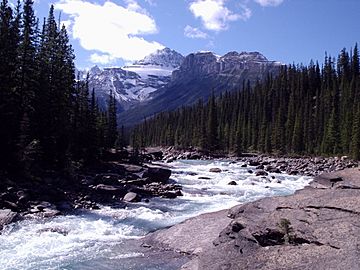Mount Sarbach facts for kids
Quick facts for kids Mount Sarbach |
|
|---|---|

Mount Sarbach seen from Mistaya Canyon
|
|
| Highest point | |
| Elevation | 3,155 m (10,351 ft) |
| Prominence | 412 m (1,352 ft) |
| Parent peak | Mount Chephren (3274 m) |
| Listing | Mountains of Alberta |
| Geography | |
| Location | Alberta, Canada |
| Parent range | Waputik Mountains Canadian Rockies |
| Topo map | NTS 82N/15 Mistaya Lake |
| Geology | |
| Age of rock | Cambrian |
| Type of rock | Sedimentary |
| Climbing | |
| First ascent | 1897 by J. Norman Collie, G.P. Baker and Peter Sarbach |
| Easiest route | Difficult Scramble |
Mount Sarbach is a tall mountain found in Banff National Park in Alberta, Canada. It sits between the Mistaya River and Howse River. You can easily see this impressive peak from the famous Icefields Parkway.
The mountain is named after Peter Sarbach, a mountain guide from Switzerland. He helped J. Norman Collie and G.P. Baker make the first climb to the top in 1897. Mount Sarbach is located south of Saskatchewan River Crossing, where the Icefields Parkway meets the David Thompson Highway.
What is Mount Sarbach Made Of?
Like other mountains in Banff National Park, Mount Sarbach is made of sedimentary rock. This type of rock forms from layers of sand, mud, and tiny bits of sea creatures that settle at the bottom of ancient seas. Over millions of years, these layers get pressed together and turn into solid rock.
How the Mountain Formed
The rocks that make up Mount Sarbach were laid down a very long time ago, between the Precambrian and Jurassic periods. Imagine shallow seas covering this area! Later, a huge event called the Laramide orogeny happened. This was when massive forces pushed the Earth's crust, causing these sedimentary rocks to fold and lift up, forming the mountains we see today.
Glaciers on the Mountain
Mount Sarbach also has a glacier on its southeast side. This glacier is shared with nearby Kaufmann Peaks. Glaciers are like slow-moving rivers of ice that carve out the landscape over time.
Weather Around Mount Sarbach
Mount Sarbach has a subarctic climate. This means it has very cold winters with lots of snow. Summers are usually mild, but still cool.
Temperatures and Water
In winter, temperatures can drop below -20 °C (that's -4 °F!). With the wind, it can feel even colder, sometimes below -30 °C (-22 °F). The snow and rain that fall on Mount Sarbach eventually melt and flow into the Mistaya River and Howse River. These rivers then join the larger North Saskatchewan River.



